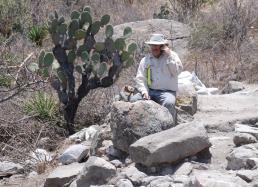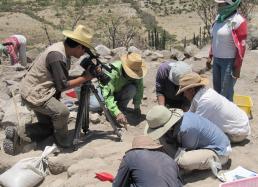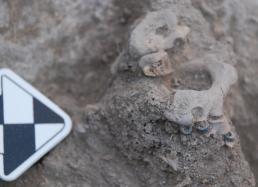8: Value
Linda and I agree that one of the more fun things to find during an archaeological excavation is a complete or near complete ceramic vesseln (see above image.) One reason why finding whole pots is fun is because invariably you find boatloads of potsherds or ceramic fragments that cannot be fit together, and so it’s incredibly rewarding to be able to view an entire pot, even if you have to reconstruct it from pieces, and even if the vessel itself is plain/undecorated.
Finding whole vessels is rare because the passage of time conspires against it. Most of what archaeologists find is trash, and why would people throw away a usable piece? In other words, most ceramic artifacts enter the archaeological record as fragments. Whole pots rarely are part of trash per se.
In our excavations in the Valley of Oaxaca, the complete ceramic vessels that we’ve recovered have come from three main contexts, all of which have ritual connections as some kind of purposeful offering. Generally, complete pottery pieces are:
- Placed as grave goods accompanying a burial, or left subsequent to the initial interment of a burial near the funerary context (see Photo #1 below),
- Placed down between the construction levels of a building or house during an episode of reconstruction or remodeling,
- Placed as an offering at the termination of a domicile’s or structure’s use.
Of course, even when a vessel is placed in the ground complete, it may not stay that way as subsequent construction, use of the dwelling, earthquakes, root activity, erosion, and post-occupational farming are only some of the forces that can break a vessel and redistribute its pieces far and wide.
This field season, we’ve had the unprecedented good fortune to find complete pottery vessels or vessels that can be reconstructed. I don’t have a final count, but the running total exceeds four dozen (almost all of them undecorated and rather plain). This unusual count raises two immediate questions. How is this recovery most relevant to our interests, and why does this particular terrace/house have so many vessels?
The first question is easier to address. As I’ve said before, all of the artifacts that we recover are to be housed permanently in Mexico (in accord with the current laws of Mexico and the United States), so while we feel great when we find a whole pot, the recovery of specific pieces has little to do directly with our research aims.
Yet, we’re excited about this collection of ceramic vessels, because in conjunction with what we’ve found and learned in previous seasons, having so many whole vessels will help us a great deal when it comes to trying to determine how ceramic artifact styles and preferences shifted over the five-to-seven centuries when this house at the Mitla Fortress was in use.
For almost a century, archaeologists have struggled with the issue of Monte Albán’s loss of regional hegemony at the end of the Classic period. This problem has been exacerbated by problems defining how specific pottery styles changed between A.D. 600-1200. The occupation of the Mitla Fortress coincides with much of this period, and this significant sample of vessels in well-defined contexts has provided a firm foundation for better elaborating these stylistic shifts.
So while the potential of this sample is clear, the answer to the question of why there are so many whole pots is not. The terrace/residence that we are excavating is lower down the hill than those we studied in 2009 and 2010. Although the house on Terrace 276 is not markedly different in size or architectural elaboration than the two terraces excavated before, we actually have fewer rare objects or highly decorated pieces than in the two previous years. In other words, we haven’t found many things that seem fancy or highly crafted. The quantities of obsidian (exotic, volcanic glass) impressionistically feel a bit reduced in quantity compared to 2009-2010.
What we do have in abundance is offerings, of all three of the varieties described above. But most tellingly, we have many offerings that weren’t associated with burials, and most of these offerings were composed of two vessels, one sitting above another. At the same time, it appears at this point that we have fewer non-ceramic offerings (such as animals) compared to prior seasons.
At the site of El Palmillo (where Linda and I excavated eight houses during ten seasons), we noticed a very similar pattern: the higher up the hill we went, the smaller the percentage of simple ceramic offerings found, while most of the offerings recovered in houses on lower terraces were almost entirely ceramic. Higher on the hill, sacrificed animals and other non-ceramic materials were more commonly interred as offerings.
So what? Well, I may be going out on a limb here, but maybe such patterns are telling us something about relative value. If people of more humble standing are more apt to leave basic ceramic bowls and jars as offerings, while those of greater means are more likely to sacrifice animals or inter obsidian, might not one speculate that obsidian and animals were worth more or were harder to procure than basic ceramics? Food for thought, as clay is readily available and the technology associated with the making of many basic Valley of Oaxaca bowls and jars of this era was not that complex.
Whatever their prehispanic worth, the discovery of whole pots is fun. And so the stars were aligned for us this week when we found out (just a few hours prior to their arrival) that television crews were on their way to the site. When we received the call that they were en route, we fortuitously happened to be working on a number of offerings and burials, so we had something of potential interest and import for them to film (see Photos #2-4 below.)
In one burial of a child (who was interred with an adult, perhaps its mother) that we were excavating at the time, we found 34 ceramic beads, all of which were tiny and plain (see Photo #5 below.) A number of these beads were found in place lodged right against the child’s upper spinal column (at the neck). Although these beads, too, likely were of limited “value” in the past, the picture they provided today was poignant and riveting.
More soon,
Gary









